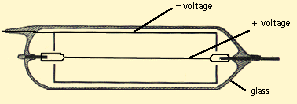|
(Files in red–history) |
An ion or electron penetrating the tube (or an electron knocked out of the wall by X-rays or gamma rays) tears electrons off atoms in the gas, and because of the high positive voltage of the central wire, those electrons are then attracted to it. In doing so they gain energy, collide with atoms and release more electrons, until the process snowballs into an "avalanche" which produces an easily detectable pulse of current. With a suitable filling gas, the flow of electricity stops by itself, or else the electrical circuitry can help stop it. The instrument was called a "counter" because every particle passing it produced an identical pulse, allowing particles to be counted (usually electronically) but not telling anything about their identity or energy (except that they must have sufficient energy to penetrate the walls of the counter). Van Allen's counters were made of thin metal, with insulating plugs at the ends.
|
